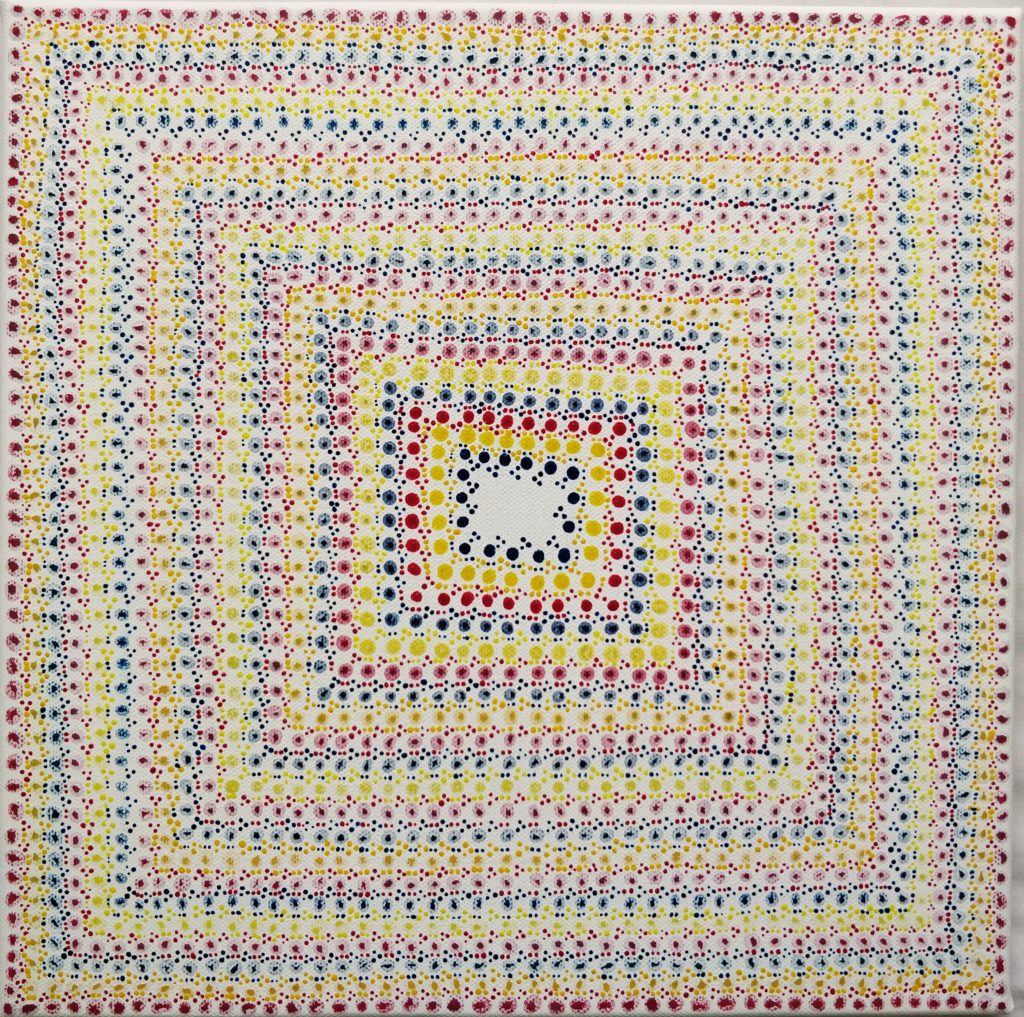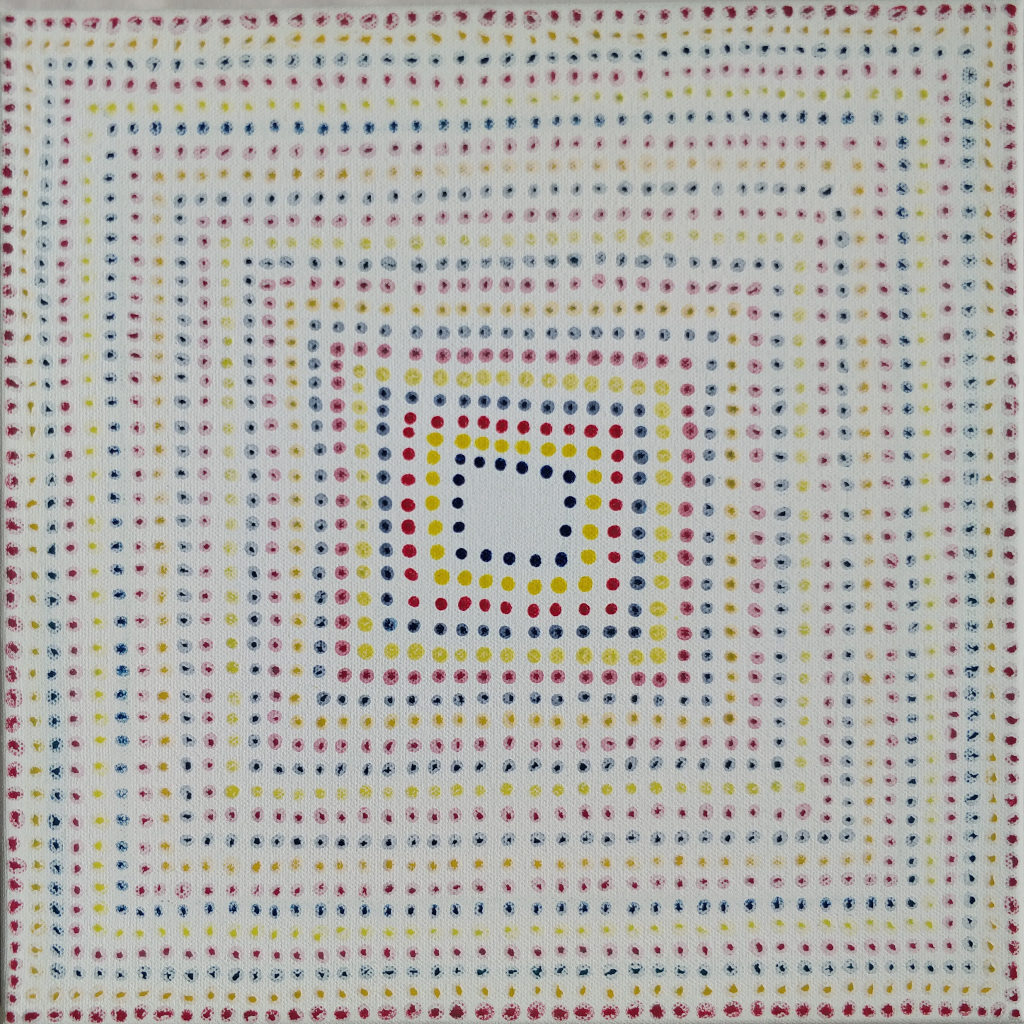
Acrylic on canvas
12 x 12 in
Square Dots #1 keeps surprising me. Twice I thought it was finished. This week I’ve been reading about patriarchy and capitalism, which has been really hard going. When I needed a break from the reading, it occurred to me to paint sets of three tiny pink dots between the pink and yellow lines of single dots. Creating this pattern gave me plenty of soothing dots to paint between readings for the research proposal I’m writing. I then felt compelled to paint yellow and blue tiny dots too. It occurred to me that I could create another pattern by painting sets of two tiny dots between the sets of three tiny dots. Again more patterns for me to paint.
Why is women’s unpaid labour hidden in our economic system?
Painting dots is so soothing. It gives my brain something non-taxing (pun not intended) to do whilst reeling from the grief of reading about the inequality of the history of economics. I watched episodes of An Economic History of the World Since 1400 (Harreld, 2016) to learn about how capitalism began. When we got to Adam Smith’s descriptions of the things that fuel the “invisible hand” of capitalism (self-interest, supply and demand, and competition), I felt outraged. What about the unpaid labour of women throughout the centuries?! Why did Harreld, a white, male PhD scholar, not mention women’s unpaid labour? Surely scholars are supposed to critique theory? Luckily, a friend pointed me to Who Cooked Adam Smith’s Dinner? by Katrine Marcal (2015). Marcal points out the obvious (if you’re a woman) fact that without women’s unpaid labour of child rearing, cooking and cleaning, it would have been incredibly difficult for the men to go out and do their self-interested profiteering.
Women artists creating social change
I stumbled across a brilliant podcast by Ruth Beale and Amy Feneck (2020) called True Currency: About Feminist Economics. It has loads of great interviews with women who are making social change with regard to immigrant workers’ rights and sex workers’ rights, amongst other things. That led me to the Milk Report by artists, Conway and Young (2019), which is a report on the economic cost of breastfeeding a child for six months if the mother was paid £8.21 an hour (London Living Wage in 2019). To make the Milk Report Young recorded the hours she spent breastfeeding her new baby for six months. They totalled 720 hours and 7 minutes, which gave a monetary cost totalling £5,916.95. It makes you think, doesn’t it? Why aren’t women paid for the care they put into creating workers for the system (I know that’s not why they do it but it is the result). Surely the system needs to take them into account!
Another aspect of patriarchy is homophobia. I watched Nanette, Hannah Gadsby’s (2018) brilliant critique of art history through the lens of lesbianism. It was brilliant because she’s a stand up comedian and incredibly funny, but she also stopped joking at points where she wanted to tell her heartbreaking story about sexism and homophobia. I cried listening to her and felt connected to her even though I only know her through this work. It was such powerful work. I loved it when she got angry. She didn’t act it out. She acknowledged it. Gadsby for Prime Minister, I reckon.
References are listed at the bottom of this post.
A soothing process aids reflection
Painting dots was necessary for me to be able to read about patriarchy and the sexism, racism, and all the other isms it sows. It gave me time to reflect and feel whilst doing a meditative action. I’ve finished all the patterns of three and two tiny dots now. I’m enjoying the psychedelic effect on my eyes that the detail provides. It’s quite different to before:



References
BEALE, R. and FENECK, A., 2020b. True Currency: About Feminist Economics [online]. Available from: https://open.spotify.com/show/12oAnU7sYno74Du9v3Mmos?utm_source=Gasworks+Newsletter&utm_campaign=a324043126-EMAIL_CAMPAIGN_2020_07_09_10_40&utm_medium=email&utm_term=0_1536a223fe-a324043126-117001957
CONWAY AND YOUNG, 2019. Milk Report [online]. Available from: http://www.conwayandyoung.com/milk-report/
GADSBY, H., 2018. Nanette [online video].Available from: https://www.netflix.com/gb/title/80233611
HARRELD, D.J., 2016. An Economic History of the World Since 1400 [online video]. Available from: https://edgehill.kanopy.com/video/self-interest-human-survival-and-history
MARCAL, K., 2015. Who Cooked Adam Smith’s Dinner? A Story About Women and Economics [Kindle eBook]. Granta Books. Available from: https://www.amazon.co.uk/Who-Cooked-Adam-Smiths-Dinner-ebook/dp/B00TOLYFOS/ref=tmm_kin_swatch_0?_encoding=UTF8&qid=1595882843&sr=8-1
